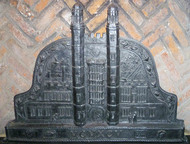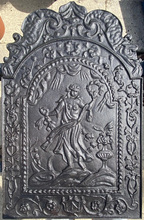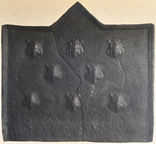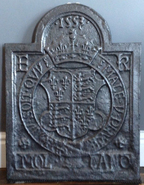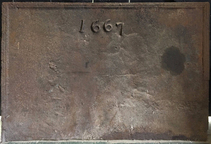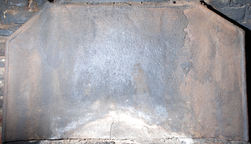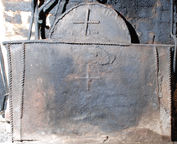-
60
Description: Fragment; rectangular; flanged top edge; probable symmetrical arrangement of crowned Tudor royal shield stamps (4 above 3); vertical line on either side of each shield; left hand print in bottom left corner, probably mirrored on right.
Notes: The right side of the fireback is missing. Very crude modelling of stamp suggests an early date; the same crowned shield and use of hand print can be seen on a fireback at Rolvenden (no. 661), indicating a common source..
- Decoration tags:
- rectangular (shape)
- flanged (edging)
- simple stamps
- carved stamps
- heraldic
- humans
Manufactured: in the early- to mid-16th century in the Weald area of England.
Current location: in private hands, Etchingham, East Sussex, England.
- Attached to series:
- Hand print firebacks
- Early Tudor series
- Tudor royal armorial firebacks
-
1179
Description: Arched rectangular shape; astragal and fillet edging (top and sides); central shield with arms of Eton College, surmounted by a small tilting shield of the pre-1603 Royal arms of England (France modern quartering England) aslant beneath a crown; to each side a spray of lilies; below, a scroll bearing the motto - Esto Perpetua; bottom left the date MCMXCII; bottom right, a panel bearing the phrase C of A and [?].
Notes: The motto Esto Perpetua means Let it be perpetual. Fireback designed by and made for Martin, Lord Charteris of Armisfield, who was Provost of Eton College 1978-91. One of a set of two cast for the college.
Copies of this fireback are known.
Inscription: ESTO PERPETUA / MCMXCII C of A [Charteris of Armisfield]
Arms: Eton College
- Decoration tags:
- rectangular with round arch (shape)
- astragal & fillet (edging)
- whole carved pattern
- heraldic
- armorial
- text
- plants
Manufactured: in 1992 in England.
Current location: Eton College, Eton, Berkshire, England.
Museum number: FDA-A.238:2-2013 (part of the Eton College museum group)
- Attached to series:
- Martin Charteris firebacks
- Corporate firebacks
-
1180
Description: Quasi-arched rectangular shape; parallel simulated twisted rope edging enclosing a border of lilies; pictorial representation of the facade and gatehouse towers of Eton College, between which is a clockface below crenellation; above left, two house martins flying; at ground level, ?four people (one of which is said to be Nigel Jaques, one of the masters) all standing on a plinth bearing, in the centre, the date MCMXCV between four small cartouches, of which to the left and nearest the date is a pack of playing cards; others bear the inscriptions, MCM and CofA (Charteris of Armisfield).
Notes: Designed by and made for Martin, Lord Charteris of Armisfield, Provost of Eton (1978-91).
Inscription: MCMXCV
- Decoration tags:
- rectangular with round arch (shape)
- rope (edging)
- whole carved pattern
- pictorial
- architectural
- monogram
- text
- animals
- humans
Manufactured: in 1995 in England.
Current location: Eton College, Eton, Berkshire, England.
Museum number: FDA-A.298-2013 (part of the Eton College museum group)
- Attached to series:
- Martin Charteris firebacks
-
1119
Description: Arched rectangular central panel with 'nutshell' over fillet edging; pictorial image of a partially clothed female figure, holding an upraised wreath in her left hand, standing on a ground, with a gadrooned vase containing flowers and leaves to the right, and above swagged drapery and sun rays; arched rectangular fillet border with descending leaves and flowers suspended from a wreath, top centre, and a wreath in each top corner; on top, mirrored sea monsters; bottom centre, logo formed of a pair of dividers in a cartouche between swirling fronds.
Notes: The figure is an allegorical representation of Agriculture, one of the Iconologia originally published by Cesare Ripa in 1613. A modern casting of an early-18th century design (see no. 1325). Copies of this fireback were advertised in Burton Weir's (Rotherham) catalogue in the early-20th century.
Copies of this fireback are known.
- Decoration tags:
- 'Dutch' (shape)
- fillet (edging)
- whole carved pattern
- allegorical
- humans
- objects
Manufactured: in the 20th century in England.
Current location: not known.
- Attached to series:
- British 'Dutch' style firebacks
- Agriculture firebacks
-
1051
Description: Rectangular with triangular arch; ovolo-moulded edging (top and sides); small stamp of a ‘Renaissance’ shield bearing the initials IC, repeated eight times 3-2-3) in a regular arrangement.
Notes: The initials have not been identified.
Inscription: IC
- Decoration tags:
- rectangular with triangular arch (shape)
- ovolo (edging)
- carved pattern panels
- heraldic
- text
Manufactured: in the mid- to late-16th century in the Weald area of England.
Current location: not known.
- Attached to series:
- Initials only firebacks
- Triangle arch series
-
1323
Description: Arched rectangular with broad fillet edges; arched rectangular inset with cavetto edging and armorial design in low relief: circular garter enclosing an ornate Tudor royal shield, surmounted by a crown; date inside top of arch; initials inside top corners of rectangle; a rose in each bottom corner of rectangle; inscription in a separate rectangular panel below, split by garter buckle.
Notes: An altered commercial copy of a Tudor fireback (no. 288) produced by F. Parkin & Sons (Exeter) and advertised in their 1972 catalogue. The width of the edges of the original fireback has been narrowed possibly to reduce weight and cost or for aesthetic reasons.
Copies of this fireback are known.
Inscription: 1553 / E R / HONV SOIT QVY MALE V PENCE / MOL LAND
Arms: Tudor royal - Edward VI
- Decoration tags:
- rectangular with round arch (shape)
- fillet (edging)
- whole carved pattern
- armorial
- royal
- text
Manufactured: in the mid- to late-20th century at Bonhay Foundry, Exeter in England.
Current location: not known.
- Attached to series:
- Edwardian royal armorial firebacks
-
1085
Description: Rectangular; rebated ovolo-moulded edging (top, left and half-right sides); top centre, date with unevenly positioned numerals.
Notes: The asymmetry of the side moulding is unusual.
Inscription: 1667
- Decoration tags:
- rectangular (shape)
- rebated ovolo moulding (edging)
- carved stamps
- individual numbers
- text
Manufactured: in 1667 possibly in the Weald area of England.
Current location: Faversham, Kent, England.
- Attached to series:
- Date only firebacks
- 1660s-90s Wealden series
-
941
Description: Arched rectangular shape; scalloping within wide fillet edging; shield, knight's helm, crest and mantling; date split either side of armorial.
Notes: The arms are of Kyrle (vert, a chevron between three fleurs de lys or; crest: on a mount vert a hedgehog or) of Much Marcle, Herefordshire, quartered with Abrahall (azure three hedgehogs or; the fess appears to be erroneous) and Warnecombe (sable, on a fess dancetty argent between three bezants each charged with an escallop of the field as many lions rampant argent armed and langued gules). The second part of the date appears to have been altered by hand for the present casting as the style of lettering for the final two numerals is crude compared with the first two. Sir John Kyrle may have operated the iron furnace at Whitchurch, between Monmouth and Ross on Wye; the style of the carving is the same as on two other firebacks in the same county. It is apparent, from another example, that this fireback has either been broken and repaired, or deliberately reduced in height. Originally the mantling of the helm extended further down, ending in tassels on each side, making the height of the fireback approximately equal to its width. An early photograph of the Fawley fireback, taken by Alfred Watkins, the Herefordshire antiquarian, shows the division of the two parts more clearly (Herefordshire Record Office, AW339b). A copy of the original, un-reduced fireback has been noted with the date 1685 in the distinctive numerals seen on firebacks from Flaxley Furnace, Gloucestershire.
Copies of this fireback are known.
Inscription: 16 20
Arms: Kyrle quartering Abrahall and Warnecombe
- Decoration tags:
- rectangular with round arch (shape)
- fillet with scalloping (edging)
- whole carved pattern
- individual numbers
- armorial
- text
Manufactured: in 1620 possibly at Whitchurch Furnace in the Herefordshire area of England.
Current location: in private hands, Fawley, Herefordshire, England.
- Attached to series:
- Personal armorial firebacks
- Herefordshire armorial series
-
65
Description: Canted rectangle; twisted rope edging; plain plate
- Decoration tags:
- rectangular with canted top corners (shape)
- rope (edging)
- simple stamps
Manufactured: in the 16th or 17th century possibly in the Weald area of England.
Current location: in private hands, Fernhurst, West Sussex, England.
- Attached to series:
- Base boards
-
66
Description: Quasi-arched rectangular shape; twisted rope edging on top and sides of rectangle, and separately around arch; the rope ends extend beyond both ends of the top edge; vertical rope lengths, to full height, inside left and right edges; rope crosses in arch and in upper centre of rectangle.
Notes: Probably an early vernacular example of a design mimicking the ‘Palladian’ style. The crosses suggest Christian significance.
- Decoration tags:
- rectangular with round arch (shape)
- rope (edging)
- simple stamps
- apotropaic
Manufactured: in the mid- to late-16th century in the Weald area of England.
Current location: in private hands, Fernhurst, West Sussex, England.
- Attached to series:
- Rope design firebacks


